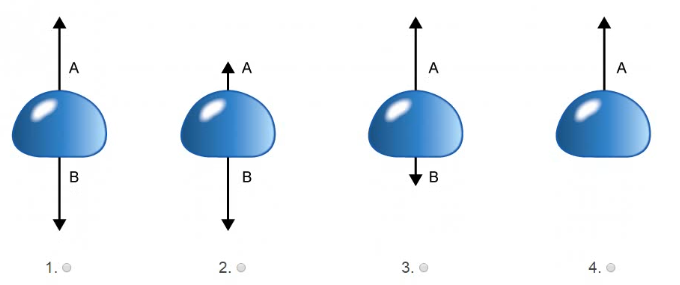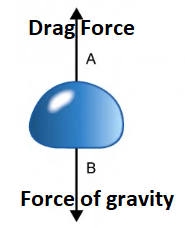IB myp 4-5 physics – Practice Questions- All Topics
Topic :Forces and energy- Forces and motion, newton’s laws
Topic :Forces and energy– Weightage : 21 %
All Questions for Topic : Newton’s laws of motion
Question a (1 mark)
The raindrop does not reach this theoretical maximum speed: instead it reaches the terminal velocity.
Select the free body diagram that shows the forces acting on the raindrop when it reaches its terminal velocity.

▶️Answer/Explanation
Ans:
In the free body diagram at terminal velocity, you would show the force of gravity acting downward and the drag force acting upward, with the two forces balancing each other out.
Ans diagram will be $(1)$
Question b (1 mark)
Label the forces A and B.
Force A………..
Force B…………
▶️Answer/Explanation
Ans:

Question (11 marks)
When the space probe in Question 2 is investigating acceleration, air resistance is negligible.
On Earth, a parachute can be used to increase air resistance.
The maximum speed a falling object reaches is known as the terminal velocity.
When an object is falling towards a planet with an atmosphere, it experiences a drag force. When the drag force is equal to the weight of the object, it stop accelerating The maximum speed the object reaches is known as the terminal velocity.
Question a (2 mark)
Some students perform an investigation into the terminal velocity of a simple parachute. One of the students wants to investigate how the area of the parachute affects its terminal velocity.
Suggest one piece of equipment that the student will need to perform this experiment,
Equipment:
Reason:
▶️Answer/Explanation
Ans:
One piece of equipment that the student will need to perform this experiment is a variably-sized parachute.
Reason:
By using a variably-sized parachute, the student can test the effect of different parachute areas on the terminal velocity. They can vary the area of the parachute by adjusting its size and observe the corresponding changes in the terminal velocity. This will allow them to investigate the relationship between the parachute’s area and its terminal velocity, providing valuable data for their experiment.